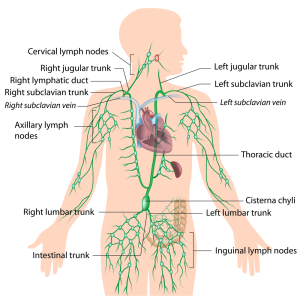Introduction
In this infection the lymphatic vessels of the skin get infected. The most common bacterium is Streptococcus pyogenes.
The bacteria enter into the lymphatic vessels from infected skin lacerations, an area of cellulitis or erysipelas, an infected wound or from an infected surgical incision following surgery. The bacteria get filtered by the lymph glands and infect the lymph nodes causing “lymphadenitis”.
Signs and Symptoms
The patient is sick looking, has a fast heart beat, chills, fever, and tender skin with streaky marks from the infected subcutaneous lymph vessels. The regional lymph glands are tender and swollen.
Diagnosis and prognosis
The diagnosis is made clinically by the physician. There is tenderness on palpation of the lymphatic vessels and the affected lymph glands. Blood tests show a marked leukocytosis (elevation of the white blood cells). Without antibiotic treatment there would be a deterioration from the toxins and bacteria in the blood and the patient would die from toxic shock syndrome or septicemia. The physician must rapidly intervene with intravenous antibiotics as the bacteria have a tendency to move rather quickly into the blood stream and spread throughout the body into vital organs.
Treatment
The treatment protocol is similar to the one described under “cellulitis” or “erysipelas” above (Ref. 3, p. 795 and Ref. 2, p.471), see links under “skin infections”.
References
1.The Merck Manual, 7th edition, by M. H. Beers et al., Whitehouse Station, N.J., 1999. Chapter 265.
2.James Chin et al., Editors: Control of Communicable Diseases Manual, 17th edition, 2000, American Public Health Association
3.The Merck Manual, 7th edition, by M. H. Beers et al., Whitehouse Station, N.J., 1999. Chapter 112.
4. The Merck Manual, 7th edition, by M. H. Beers et al., Whitehouse Station, N.J., 1999. Chapter 115.
5. The Merck Manual, 7th edition, by M. H. Beers et al., Whitehouse Station, N.J., 1999. Chapter 113.
6. Suzanne Somers: “Breakthrough” Eight Steps to Wellness– Life-altering Secrets from Today’s Cutting-edge Doctors”, Crown Publishers, 2008







